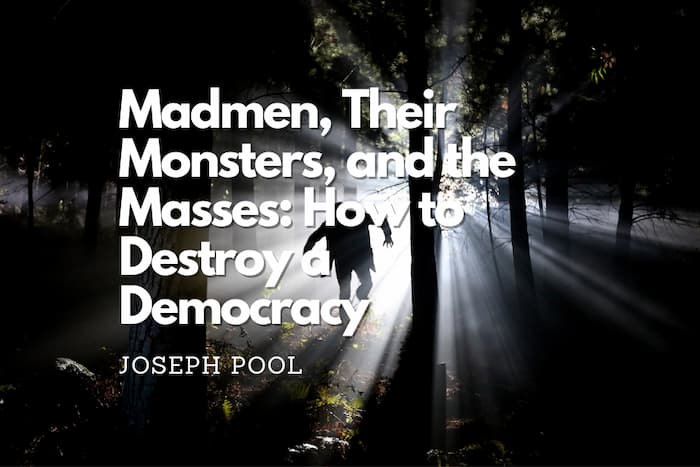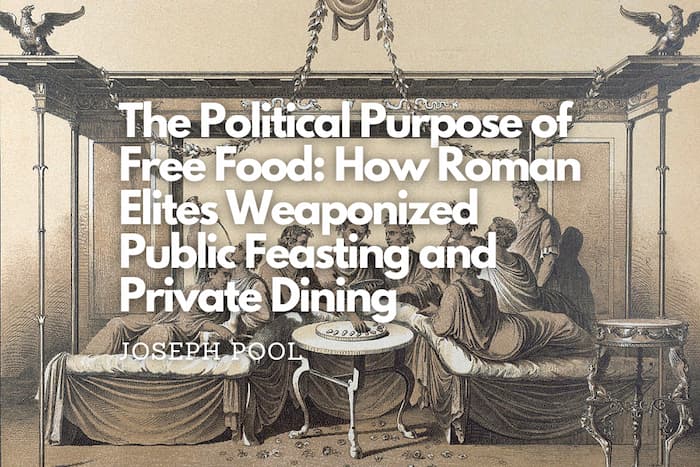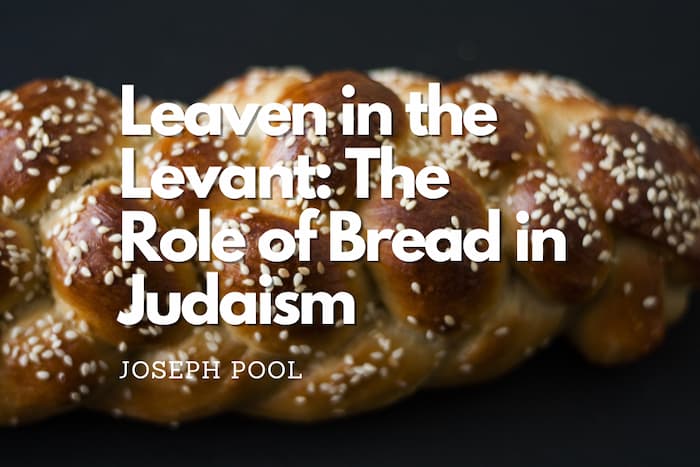Joseph Pool
PHI 242: Zombies, Serial Killers, and Madmen
December 9, 2022
INTRODUCTION
Throughout their relatively short time of preponderance around the world, democracies have changed the way that people and their governments interact. Instead of an absolute ruler who makes decrees on a whim, the people themselves are given the power. While some democracies were more limited than others, such as the stringent criteria of Ancient Athenian citizenship, they are united with a common purpose: providing everyone with equal protection and responsibility under the law. These laws are based on the changing ideas of the state’s citizens. Thus, for a democracy to thrive, its people must be encouraged to know the laws, learn their history, and question any “leader” who attempts to strip them of their democratic powers and purpose. They must be resilient to the empty promises of these leaders: the power-hungry madmen.
Capable of captivating and mesmerizing the minds of millions, the madman endeavors to ensure that their constituents willingly and zealously lend their rights and support to these aspiring autocrats. For him to be successful, the masses must fervently propagate and promote his ideas. Given some power, he quickly suspends the legitimate institutions that have a hope of stopping him and props up heartless, sadistic serial killers to enforce his cultural and ideological hegemony. He taps into the primal fear centers of people’s brains that allow them to cheer on and participate in the atrocities committed by the madman’s cadre of killers. From his marbled mansion, the madman releases the monsters of society and sets them on any who dare dissent. From this reign of terror begins the downfall of democracy. This paper will examine neurological zombies, serial killers, madmen, the “sleepy” killers and the role they all play in heralding the death of a democracy. It will also explore the extent to which the risk of this collapse and the casualties it causes can be mitigated or stopped altogether.
DANGEROUS DEVIANTS
Ramachandran’s neurologically-nonconscious zombies,[1] Vronsky’s paraphilia-pursuing serial killers,[2] and Victor’s extremist-embracing madmen[3] may be different types of “monsters” but a common thread binds them all. These are not merely mythical monsters; they are dangerous deviants that live among us. To understand how one can bring about the death of a democracy, one must first fully understand what makes these groups terrifying: that given the right circumstances, anyone can possess the markings of these deviants. These monsters are crafted as a result of a series of neurological, psychological, or sociological problems plaguing us. When enough societal and mental safeguards are tossed away, the monsters within people come out to play.
The first of these groups, and possibly the most widespread, are Ramachandran’s zombies. In his book, Phantoms in the Brain: Probing the Mysteries of the Human Mind, famed neuroscientist V. S. Ramachandran utilizes a series of case studies and avant garde research to put forth a new theory to explain human consciousness: the Neuro-Bio-Chemical Theory of Consciousness. Determining its need, he reasons, “there’s a new way to study consciousness, not as a philosophical, logical or conceptual issue, but rather as an empirical problem.[4]” He believes that consciousness is created when three key concepts are all present in an individual and interact with one another. For someone to be conscious, according to Ramachandan, the individual must have stability of their perception, the ability to access and create memories, and the ability to make decisions based on the stimuli around them.[5] He explains this by examining a case in which a patient believed she could not control her hand, despite no physical cause preventing its movement. He questions, “Is the alien left hand controlled by an unconscious zombie, or is it controlled by parts of her brain that have qualia and consciousness?[6]” Using his criteria for consciousness as a baseline, he continues, “Does the system in her brain that moves her arm create an irrevocable representation? Does it have short-term memory? Can it make a choice?[7]” Ramachandran asserts that all three criteria must be present for an individual to possess the prerequisites of consciousness.
To fully become conscious, however, requires one more step: the regions of the brain that make these components of consciousness possible must be synchronized. Ramachandran explains it as, “the actual patterns of nerve impulses (spikes) from widely separated brain regions become “synchronized” when you pay attention to something and become aware of it. In other words, it is the synchronization itself that leads to conscious awareness.[8]” This synchronization is a feat that can only occur at 40 Hz of brain activity or more.[9] Below that threshold, different parts of the brain were found to lose the ability to communicate and process stimuli with one another. Discussing the danger that occurs under 40 Hz, Ramachandran warns,“when these structures are disconnected, disorders of “free will” occur, such as akinetic mutism and alien hand syndrome.[10]” Below the 40 Hz threshold and above the 15 Hz threshold is where an individual enters a state of only partial consciousness. Within that range, the zombie emerges to hijack the once conscious mind.
Within the brain, information and stimuli are processed through two pathways: the “what” pathway[11] and the “how” pathway.[12] Existing in the more evolved temporal lobes, the “what” pathway is a comparatively modern pathway that allows for conscious perception to occur by allowing the brain to interpret details of what is seen. In comparison, the “how” pathway exists near the brainstem, in the primitive brain, and remains responsible for unconscious movements such as reflexes.[13] They work in tandem and allow people to do an action and understand it. Without one, the individual is limited in their capabilities. As an example of when one pathway was severed from the other, Ramachandran recounts the case of a patient who believed she was blind despite having working eyes. Ramachandran elaborates, “She couldn’t tell the difference between a horizontal and a vertical pencil or a slit because her what pathway had been selectively obliterated. But since her how pathway was still intact … she was able to reach out and grab a pencil accurately or rotate a letter by the correct angle to post it into a slot that she could not see.[14]” When an individual is fully conscious, their brain often divides tasks between these two goals, and they remain fully aware of what they have done. But when an individual’s brain falls below 40 Hz of oscillation, they enter a semi-conscious state in which they are not aware of what they are doing, and they are unable to self-reflect. In this state, the what pathway is rendered obsolete and the how pathway assumes control of mental and thus motor function.[15] This is how the zombie is released to guide the body while it remains in a state of autopilot.
While zombies exist to a certain extent within everyone, not all zombies are created equal. Some only assume control in fleeting moments or for beneficial reasons. Its ability to tap into reflexes and quickly process stimuli allows the zombie to engage in complex behaviors, not just simple tasks. Ramachandran goes as far as to suggest, “Indeed, in sports as in many aspects of life, it may pay to “release your zombie” and let it do its thing.[16]” Unfortunately, the neurological zombie is not always a benevolent entity. Sometimes, it uses the body to commit heinous acts. In the case of Kenneth Parks,[17] for example, his zombie was particularly potent and deadly. He was documented driving nearly 15 miles to the home of his in-laws. Once there, he took a tire iron from the garage and murdered them with a combination of strangulation and the infliction of blunt force trauma.[18] Parks was not conscious or in control; his zombie was. With its stability of perception and decision-making intact, the zombie was able to engage in a series of coordinated, complex actions that led to the deaths of his in-laws. However, the lack of an ability to form new memories and the loss of access to his “what” pathway prevented Parks from understanding his actions and stopping himself from engaging in them. He was acquitted, as he and other true zombies lack a guilty conscience. They are unaware and unwitting slaves to their own actions and as such, they can not be said to have the mens rea necessarily in proving legal guilt. While this monster may murder, it does so with the individual unaware of their actions and unable to stop it from wreaking havoc. The lack of control people have over their zombies can render it a threat to many. However, that same inability to focus it may ensure that a madman can not rely on the zombies to bring about his or her dominion. To understand how some monsters can cause the death of a democracy, it is imperative to view the zombie as a foil to the truly guilty parties: the serial killers, the madmen, and the people.
Far from the unwitting and unaware zombies, Vronsky’s serial killers are sadists, driven to kill by their repressed sexual behaviors and fantasies. According to Peter Vronsky, the author of Serial Killers: The Method and Madness of Monsters and Female Serial Killers: How and Why Women Become Monsters, the pleasure they get from engaging in their crimes drives them to commit more and to pursue their paraphilic interests constantly. He refers to them as “predatory sexually charged [killers],[19]” giving credit to the fact that the FBI often classifies these serial murders as acts of “sexual homicide.[20]” Unlike zombies, these monsters do not suffer from a lack of conscious awareness of their crimes. In fact, some killers, such as Samuel Little,[21] revel in them. During his interrogation, Little passionately recounted explicit, intimate details of his more than 90 murders and his paraphilic obsession with the girls he targeted.[22] These serial killers are unlike mass murderers or soldiers in both their sexual paraphilias and their unique pattern of behavior. They engage in an “intense cycle that begins with homicidal sexual fantasies that in turn spark a desperate search for victims, leading to their brutal killing, followed by a period of cooling off and a return to normal daily routine—with all its unbearable stresses, disappointments, and hurts, which lead back to the reemerging need to start fantasizing about killing again.[23]”
Vronsky and the FBI make a further distinction based on how the killers operate: they are either “disorganized,” “organized,” or “mixed.[24]” Disorganized killers, such as Charlie Chop-off and Jack the Ripper, commit crimes of opportunity; when the urge to kill strikes, they use whatever is around them. Vronsky explains, “The disorganized serial killer usually attacks his victims spontaneously … The victim is frequently overcome by a violent “blitz” attack and the weapon is often an object found nearby.[25]” In contrast, “organized killers” such as BTK and Ted Bundy select the time, place, and manner of their murders with excruciating effort. Vronsky elaborates, “[an organized killer] thinks through his crimes, often for weeks, months, and even years, before acting … The killer is methodical and orderly in his crime.[26]” He continues, “The organized serial killer is a perfectionist, constantly improving his technique with each additional murder. The longer he kills, the more difficult he becomes to capture.[27]” There are also “mixed killers,” such as Jeffrey Dahmer and the Night Stalker, who sometimes kill in planned-out ways and other times, commit crimes of opportunity.
While their methods may seem different, all three classifications of serial killers have the same effect on society around them: they foster fear and suspicion within their communities. The threat they pose to democracy is an immense one. On their own, they may kill with pleasure and reckless abandon. Still, when given the reigns of institutions, as in the case of Nazi Germany, they can commit their sadistically-charged atrocities on an inconceivable scale. This happens because of the machinations of a madman.
The madman is the shepherd of a dying democracy. Far from the Enlightened and visionary thinkers who created it, the madman attempts to warp and pervert it to serve his interests. They do not spontaneously appear. Often, numerous factors must be present to allow one to assume power in the first place. George Victor, a psychologist and the author of Hitler: The Pathology of Evil, explains what allowed for Germany to openly accept a madman. He explains, “history made Germany a fertile soil for Hitler’s message of victimization, outrage, and vengeance.[28]” Following the harsh sanctions at the end of WW1 and the failure of the Weimar Republic to alleviate economic and social problems within Germany, people were desperate for a message of hope. They faced “political instability with no end in sight … worsening economic disaster … rapid social change … and paranoid distrust and resentment of leaders.[29]” They wanted someone who could restore their pride and repair their provinces. They believed that they found it in Hitler. As most madmen, he placed himself on a pedestal and assured people that he was the only solution to all their ailments. Victor illustrates, “To his followers, he was omnipotent, omniscient, and infallible, acclaimed as the greatest leader in history and as a god.[30]”
Madmen like Hitler often suffered from setbacks or a lack of agency in their younger years. Victor reflects, “That [Hitler] was a sadist is accepted, but that he was also a masochist is not. Particularly difficult is the matter of his victimization in childhood.[31]” The madman uses a combination of charisma, fear tactics, and populist practices to convince the public to initially lend their support. Victor goes as far as to say, “Since most Germans did not support the policies that set Hitler apart from his rivals, why did they support him? The main reason was his charisma.[32]” For people to look past the atrocities that will undoubtedly be committed, they must not just believe that the madman is a good leader. They must fully embrace him as a demigod and his ideas as divine in origin. Victor describes, “He believed he could overcome all obstacles and defeat armies vastly superior … what he believed was important because he conveyed it to his followers, inspiring their belief.[33]” When finally entrusted with a position of power, the madman attempts to overcompensate for their childhood repression by rapidly amassing power and transmuting political supporters into unquestioning followers.
Democracies begin their decomposition when this threshold is crossed and the beliefs of the madmen are viewed as the truth. In order to ensure this transition to autocracy, the madman relies on sprouting seeds of distrust in existing institutions and using his political capital to hijack them for personal benefit. Victor explains, “Academic hours in public schools were shortened … less time was required to graduate. The number of college students soon fell to 40 percent of what it had been, and eventually most colleges were closed.[34]” In just a few years, Hitler was able to dismantle what was considered by many to be among the best academic systems in the world. Without critical analysis, history, political science, and philosophy classes, more and more of the population did not have the tools or techniques to question their leader’s legitimacy. They could no longer separate belief from fact, making them the perfect targets to be brainwashed and seduced by the Nazi mythos.
With the support of the uneducated masses in his pocket, Hitler began to replace the institutions around him by filling them with those that would carry out his bidding: the serial killers. Madmen assuming power prompts the possibility of the death of a democracy but the killers becoming leaders often denotes the beginning of the end. Victor notes, “[Hitler] also surrounded himself with sadists including Joseph Goebbels, Herman Goring, and Streicher, and in general his Stormtroopers and SS men were sadistic. His sadism and theirs contributed to the brutalization of life.[35]” By allowing prolific killers such as the “Angel of Death“ and Irma Grese to possess autonomy in committing their paraphilically-driven acts of cruelty, Hitler promoted a culture of violence and cultivated a hegemony of hatred. The final blow to a democracy comes directly from this decision. If given enough time and devotion, the madmen, with the help of his serial killers, release the most deadly monster of all: the “sleepy killer” within the average person.
Prior to this point, many democracies can be saved. Madmen only emerge as a solution to seemingly endless economic and social hardships. Their claims of political divinity can be countered by educated or skeptical citizens. Even if they ascend to power, the state’s academic, legal, and political institutions often present them with an insurmountable obstacle in achieving absolute rule. As long as either the public or the political systems are working properly, democracy will rebound and the madman will never get the opportunity to put his killers in place. In some cases, however, there is a tangible point of no return for the society. In the case of Hitler, his charisma and promotion of blind faith enabled him to enamor millions while his political savvy and hordes of enforcers prevented the already-weakened institutions from stopping his rise. This perfect storm of catastrophes created the ideal situation for Hitler to unleash Vronsky’s sleepy killer: the harbinger of hatred.
Vronsky explains, “the so-called “sleeper” is a very common trait to most people—that all human beings have a primary capacity for violence. There is a little bit of a serial killer in all of us.[36]” Like the zombie, the sleeper exists as a typically-dormant feature of our primitive brain. It acts as the “fight” when fear triggers a fight or flight response. Unlike in the case of the zombie, however, the individual is fully aware of the actions of their latent killer, remembering the details years later, like in the case of Petras Zelinonka[37] who volunteered to kill dozens of his Jewish neighbors. A successful madman is one who understands this societally-shunned and suppressed part of the human psyche that craves violence, and encourages its expression. Hitler acknowledges, “I as a politician need a conception which has hitherto existed … to be abolished and an entirely new and anti-historic order enforced and given an intellectual basis … [If there were no Jew] we should have then to invent him. It is essential to have a tangible enemy.[38]” Hitler and his henchmen knew that for the sleepy killer to come out and thus, for their democracy to die, the people needed to be united in fear and animosity. According to Rees, Himmler was acutely aware of this fact and in speeches, he presented a dichotomy of “us” (the German people) versus “them” (the Jewish people and other minority groups).[39] The German people were enticed to embrace this message, and with serial killers at the helm, this hatred and violence was promoted. During Kristallnacht and similar events, the sleepy killer was awakened and allowed to run rampant, burning down Jewish businesses and beating up Jewish families as large crowds cheered. Until the sleepy killers are released, ideas and institutions can counter this catastrophe, stop the serial killers, and make away with the madmen. As Victor suggests, “The main tasks guarding against new holocausts are to reduce our acceptance of charismatic would-be killers and our reliance on scapegoating to solve national problems.[40]”
People can preserve their democracies and prevent their downfall by protecting institutions and proactively ensuring that any one person does not have unlimited reign. Zombies, serial killers, and madmen can be stopped by following Victor’s advice[41] and siding with laws and logic, not leaders and their legions. Unfortunately, when these rules are not followed, cases like that of Hitler can arise, and the monsters of the world can amass. The sleepy killer is let out of its slumber and the madmen and serial killers guide it to gleefully glorify genocide. Once this dormant danger is enticed to emerge, there is no hope for the society and nobody remains to defend its statutes. Thus, democracy dies not by the machinations of a monster but by the malice of the masses that venerate it.
OBSTACLES AND OBJECTIONS
Many may object to the prevalence of the “sleepy killer” and the irreversibility of a democracy’s downfall that it may bring about. These people are optimistic about the human condition and often try to justify the numerous historical examples by discounting the role of serial killers and sleepy killers. Discussing the view of the historian Zygmunt Bauman, Vronsky writes, “he is very critical of the “faulty personality” as a cause behind cruelty. Evil is situational.[42]” Victor would counter when he notes the fact that humans need to be guided into socially acceptable standards. He clarifies, “The lack of inborn controls lays a heavy burden on education, moral training, and socialization … the need is crucial.[43]” Another issue with Bauman’s argument is that it does little to debunk the sleepy killer. In fact, the “situational” nature of evil he promotes perfectly aligns with the fact that leaders such as Hitler needed to create a sense of fear and division within people.
Others may take a different issue with the idea of sleepy killers bringing about destruction. They may believe the point of no return for democracy comes earlier, before the emergence of Vronsky’s sleeper. However, if this were the case, many more democracies would have presumably collapsed in the modern day. American leaders have constantly had their power placed in check by a population that has successfully gotten Presidents to resign and to change their policies. The discernible difference between the United States and Nazi Germany is that institutions and ideas have remained intact and kept the sleepy killer from propagating in the US. Due to this, efforts by would-be madmen to erode democracy have remained relatively limited in scope and scale. If it were just a leader responsible for a democracy’s death, then this difference would be a moot point, and the US would be a far different place.
Finally, some would deny the idea that there is no saving a democracy replete with killers. The issue with this argument is figuring out exactly how it would be saved and what exactly would be left. As noted earlier by Victor, “[Hitler’s] Stormtroopers and SS men were sadistic … their [sadism] contributed to the brutalization of life.[44]” Removing the moral and legal implications of hatred in a society is key to a madman’s pursuit of power. If a nation has reached this point of hegemony, then the laws and institutions that govern it would have already been corrupted to their core and the sleepy killer would have emerged. Once this silent, sleeping killer is awakened in the masses, it remains out. This was evident in the case of Petras Zelionka, the simple farmer, who, decades after committing mass murder on people he had lived next to for years, felt no remorse or guilt.[45] Even if the madman could be deposed, the laws would need to be stricken, and the serial killers in power would need to be searched for and purged. The democracy of the past would be long gone, with only the hopeful possibility of creating a new one in the future.
CONCLUSION
The threat of madmen, their monsters, and the malicious masses is one that could herald the death of a democracy. For this to occur, there must be an existing “breach in political and social structures[46]” believed to go unaddressed by current leaders and practices. This leads to a craving for radical change and a leader with a unique, unified vision. Thus, the madman finds his opening and presents his delusions of grandeur and false pretenses of purpose as the truth. Victor reiterates, “Germany’s more responsible political leaders stopped cooperating with each other or respecting the law, widening the breach. Into it stepped a man recovering from a mental breakdown, offering himself as Germany’s savior. He found doors open to him, and his paranoid vision became the order of the day.[47]”
Once in this place of power, the madman uses the support of the people to shut down the academic and political institutions which may pose a future threat to him. With no challenges, he then hijacks the legal and social institutions, placing his cult of monsters in power and allowing them to corrupt society, encouraging them to aid in blurring the lines of right and wrong, fact and fiction. Finally, with no ideas or institutions to challenge his absolute authority and claims of supremacy, he looks towards the masses for the final strike to democracy. He uses fear and falsehoods to sew distrust of the opposition and create division within communities. He alone reunifies the people in hatred of a common enemy. Once morals and laws are labeled obsolete, the sleepy killers awaken in the population and the death blow to a democracy has been dealt. Once society reaches this fever point, there is no return or restitution. The people themselves welcome their demise and cheer on the transition from democracy to dictatorship. In reaction to the ascension of a different madman and the words of Star Wars’ Padme Amidala, “this is how liberty dies … with thunderous applause.[48]”
WORKS CITED
Joliot, M., Ribary, U., & Llinás, R. (1994). Human oscillatory brain activity near 40 Hz coexists with cognitive temporal binding. Proceedings of the National Academy of Sciences, 91(24), 11748–11751. https://doi.org/10.1073/pnas.91.24.11748
Law&Crime Network. (2021, April 16). Samuel Little: The most prolific serial killer in U.S. history – in his own words. YouTube. Retrieved October 2022, from https://youtu.be/408H_So2SJ4
Ramachandran, V. S. (1998). Phantoms in the brain: Probing the mysteries of the human mind. HarperCollins.
Rees, L. (1997) The Nazis: A warning from history. [Documentary].
Star Wars (2005) Star Wars Episode III: Revenge of the Sith. [Movie].
Victor, G. (1998). Hitler: The pathology of evil. Brassey.
Vronsky, P. (2007). Female serial killers: How and why women become monsters. Berkley.
Vronsky, P. (2004). Serial killers: The methods and madness of monsters. Berkley.
World Science Festival. (2015). The curious case of Kenneth Parks [Video]. Youtube. https://youtu.be/AuWAkREjl6U
-
V.S. Ramachandran, Phantoms in the Brain: Probing the Mysteries of the Human Mind (1998) ↑
-
Peter Vronsky, Serial Killers: The Methods and Madness of Monsters (2004) ↑
-
George Victor, Hitler: The Pathology of Evil (1998) ↑
-
Ramachandran, Phantoms in the Brain, p. 228 ↑
-
Ramachandran, Phantoms in the Brain, p. 250 ↑
-
Ibid ↑
-
Ibid ↑
-
Ramachandran, Phantoms in the Brain, p. 234 ↑
-
Joliot, “Human oscillatory brain activity near 40 Hz coexists with cognitive temporal binding,” Proceedings of the National Academy of Sciences ↑
-
Ramachandran, Phantoms in the Brain, p. 252 ↑
-
Ramachandran, Phantoms in the Brain, p. 115 ↑
-
Ibid ↑
-
Ramachandran, Phantoms in the Brain, p. 276 ↑
-
Ramachandran, Phantoms in the Brain, p. 79 ↑
-
Ramachandran, Phantoms in the Brain, p. 78 ↑
-
Ramachandran, Phantoms in the Brain, p. 83 ↑
-
World Science Festival, “Curious Case of Kenneth Parks” (2015) ↑
-
Ibid ↑
-
Peter Vronsky, Female Serial Killers: How and Why Women Become Monsters (2007), p. 19 ↑
-
Vronsky, Serial Killers, p. 76 ↑
-
Law&Crime Network, “Samuel Little: The most prolific serial killer in U.S. history – in his own words” (2021) ↑
-
Ibid ↑
-
Vronsky, Serial Killers, p. 21 ↑
-
Vronsky, Serial Killers, p. 76 ↑
-
Vronsky, Serial Killers, p. 77 ↑
-
Ibid ↑
-
Ibid ↑
-
Victor, Hitler, p. xiv ↑
-
Victor, Hitler, p. 2 ↑
-
Ibid ↑
-
Victor, Hitler, p. 5 ↑
-
Victor, Hitler, pp. 226-227 ↑
-
Victor, Hitler, pp. 92-93 ↑
-
Victor, Hitler, p. 23 ↑
-
Victor, Hitler, p. 61 ↑
-
Vronsky, Female Serial Killers, p. 384 ↑
-
Laurence Rees, The Nazis: A Warning from History (1997) ↑
-
Victor, Hitler, p. 129 ↑
-
Rees, The Nazis ↑
-
Victor, Hitler, p. 225 ↑
-
Ibid ↑
-
Vronsky, Female Serial Killers, p. 384 ↑
-
Victor, Hitler, pp. 225-226 ↑
-
Victor, Hitler, p. 61 ↑
-
Rees, The Nazis ↑
-
Victor, Hitler, p. 225 ↑
-
Ibid ↑
-
Star Wars, Revenge of the Sith (2005) ↑




